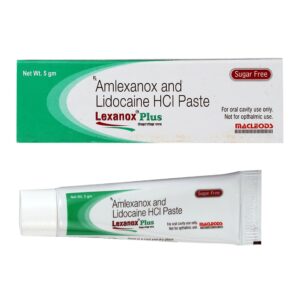LIDOCAINE (LIGNOCAINE OR XYLOCAINE) + AMLEXANOX
Lidocaine (lignocaine Or Xylocaine): Lidocaine, also known as lignocaine or Xylocaine, is a local anesthetic drug that is commonly used to numb an area of the body before a medical procedure or surgery. It belongs to the amide class of local anesthetics.
Mechanism of action: Lidocaine works by inhibiting the conduction of nerve impulses in the area where it is applied. It blocks sodium channels in the cell membranes of nerve fibers, preventing the generation and transmission of pain signals.
Use: Lidocaine is used for various purposes, including:
1. Local anesthesia: It is applied topically or injected to numb a specific area of the body, such as skin, mucous membranes, or dental tissues.
2. Pain relief: Lidocaine can be used to alleviate pain from conditions like minor burns, insect bites, and sore throat.
3. Cardiac conditions: It is also used as an antiarrhythmic agent to treat certain abnormal heart rhythms.
Dose: The appropriate dose of lidocaine depends on the specific application and the individual patient. It is usually administered by healthcare professionals. For topical application, the concentration of lidocaine can vary between 1% and 5%. Injections are usually given in doses of 0.5 to 4.5 mg/kg body weight.
Side effects: Common side effects of lidocaine include:
1. Skin reactions: It may cause redness, itching, or a numbing sensation at the application site.
2. Nausea or vomiting: This is more common with systemic use.
3. Dizziness or drowsiness: Lidocaine can cause mild central nervous system effects.
4. Allergic reactions: Some individuals may experience an allergic reaction to lidocaine, which can include rashes, swelling, or difficulty breathing.
Serious side effects are rare but may include seizures, irregular heart rhythms, or severe allergic reactions. It is important to inform the healthcare provider of any previous allergies or medical conditions before using lidocaine.
Note: Lidocaine should only be used under medical supervision and as prescribed. The information provided here is a general overview and should not replace professional medical advice.
Amlexanox: Amlexanox is a drug that is used to treat recurrent aphthous ulcers, also known as canker sores, in the mouth. It is available as a paste or gel and is applied directly to the affected area.
The exact mechanism of action of Amlexanox is still not fully understood, but it is believed to have anti-inflammatory and immunomodulatory effects. It inhibits the release of inflammatory mediators, such as histamine and leukotrienes, and reduces the migration of neutrophils to the site of inflammation. By doing so, it helps to reduce pain and inflammation associated with canker sores.
The dose of Amlexanox varies depending on the formulation. For the paste, a small amount is applied to the affected area four times a day after meals and at bedtime. For the gel, a thin layer is applied to the sore area four times a day. It is important to follow the dosing instructions provided by your healthcare provider or on the product label.
Common side effects of Amlexanox include a burning or stinging sensation at the application site, itching, and dryness. These side effects are usually mild and resolve on their own. However, if you experience severe or persistent side effects, it is important to seek medical attention.
Rarely, allergic reactions may occur, resulting in symptoms such as rash, swelling, or difficulty breathing. If you experience any signs of an allergic reaction, you should seek immediate medical attention.
It is important to note that Amlexanox is only indicated for the treatment of canker sores and should not be used for other conditions without the recommendation of a healthcare provider.

